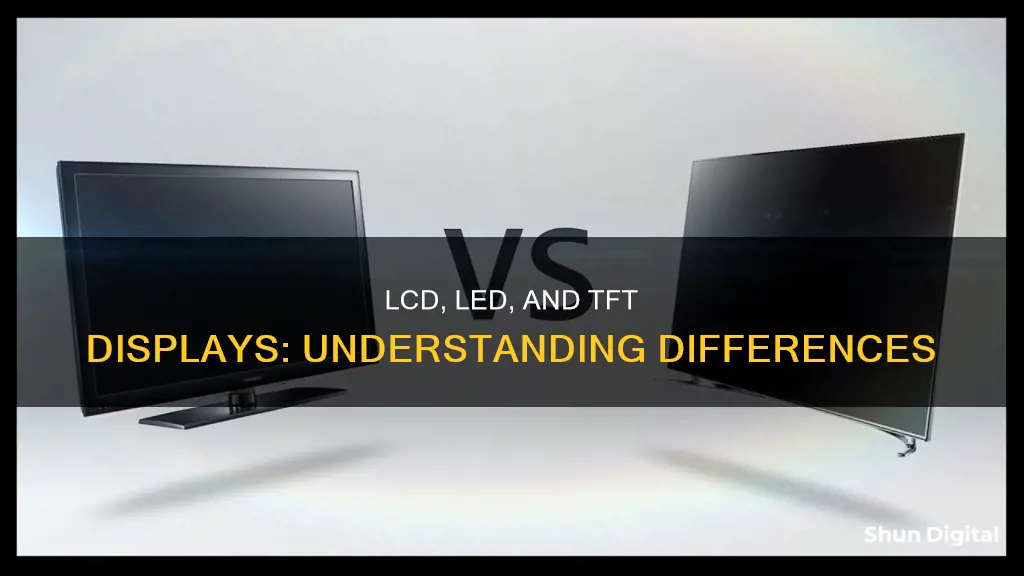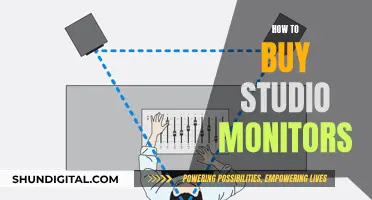
There are three common types of displays available in the market: LED, LCD, and TFT. All three refer to the flat-panel display, or screen, of a computer monitor or television set. LED stands for Light-Emitting Diode, LCD stands for Liquid Crystal Display, and TFT stands for Thin Film Transistor. While LED and LCD are often pitted against each other, TFT is a technology applied to an LCD panel to improve its performance. In this paragraph, we will explore the differences between these display technologies and how they work.
What You'll Learn

LCD, LED and TFT are all flat-panel displays
LCD stands for Liquid Crystal Display. It works by adjusting the amount of light blocked and usually has a backlight. LCD displays use the light-balancing qualities of crystals. The technology has been around for a while and is often very affordable. However, the response time can be slow.
TFT stands for Thin Film Transistor. It is a type of LCD display where each pixel has its own transistor. This results in brighter displays and smoother motion. TFT displays are known as "active-matrix" displays, which offer superior quality compared to older "passive-matrix" LCDs. They are also sharper and brighter than common LCD displays.
LED stands for Light-Emitting Diode. It is a significant improvement over fluorescent back-lighting technology. LEDs emit light rather than blocking it, as LCDs do. LED displays use LEDs as a source of illumination and control the direction of the current flow, allowing light to be emitted in only one direction. LED displays consume less power compared to TFT displays as LEDs are more energy-efficient.
TFT and LED technologies can be used together in a display. A TFT layer can be embedded in an LED display to improve performance. This combination offers superior resolution and image quality, but it also tends to be more expensive.
In summary, while LCD, LED and TFT are all flat-panel displays, they have distinct characteristics and applications. LCDs are a more mature and affordable technology, while TFTs offer improved performance and LED displays provide enhanced illumination and energy efficiency.
Choosing the Right Desktop Monitor: Understanding Size and Dimensions
You may want to see also

TFT is a technology used in premium LCD displays
TFT, or Thin Film Transistor, is a technology used in premium LCD displays. Each pixel in a TFT-based display has its own transistor, which results in a brighter display and smoother motion. This is achieved by enabling quicker on/off switching of the electrical current that illuminates the display.
TFT LCD displays are known as "active-matrix" displays, which offer superior quality compared to older "passive-matrix" LCDs. In this setup, each pixel of the display is illuminated individually, resulting in sharper and brighter visuals.
TFT screens are made using large sheets of transistors, each of which is controlled independently. This allows the electrical current that controls each pixel to turn on and off quickly, reducing response time and enhancing the smoothness of on-screen motion.
The manufacturing process of TFT screens involves applying thin films of a semiconductor (e.g., amorphous silicon) and dielectric materials to a flat, non-conductive surface (e.g., glass). The transistors are then etched from the silicon, leaving a grid of transistors and a transparent glass surface. These transistor panels are thin enough to fit between a polarised backlight and the layer of liquid crystals.
TFT LCD displays offer several advantages over other display types, such as CRT and Plasma screens. They are lightweight and thin, making them ideal for mobile phones, laptops, LCD TVs, computer monitors, and handheld devices. Additionally, TFT LCDs are energy-efficient and reasonably priced, contributing to their popularity in the display industry.
Breaking an LCD Monitor: Step-by-Step Guide
You may want to see also

LED screens use light-emitting diodes, while LCD screens use fluorescent lights
LCD stands for Liquid Crystal Display. This type of display works by adjusting the amount of light blocked and usually has a backlight, although in some cases, such as clocks, calculators, and the Nintendo Gameboy, it might not. LCD displays use the light-balancing qualities of crystals to create an image. They can produce colour based on two techniques: passive matrix and active matrix. Passive matrix is the cheapest technology of the two, while active matrix, also known as TFT, produces sharper and clearer images.
LED stands for Light-Emitting Diode. As the name suggests, LEDs emit light rather than blocking it like LCDs. LEDs are used as a source of illumination in various electronic devices, including mobile phones and large advertising billboards. When an electric current passes through an LED, it emits light. LEDs control the direction of current flow, allowing it to emit light in only one direction. This makes them more dynamic in terms of brightness range compared to fluorescent lights.
In an LED display, you will see perfect black and perfect white, which is not possible in an LCD display. LEDs also offer a wider viewing angle and higher contrast than LCDs. Additionally, LED backlights have less flicker and are more energy-efficient than fluorescent lights.
It is important to note that a TFT display is a type of LCD display. TFT stands for Thin Film Transistor, and it refers to the technology used to control how pixels are displayed on the screen. Each pixel in a TFT-based display has its own transistor, resulting in brighter displays and smoother motion. TFT displays are also known as "active-matrix" displays and offer superior quality compared to older "passive-matrix" LCDs.
Uncover Hidden Internet Monitors: A Comprehensive Guide
You may want to see also

LED screens are more expensive than TFT and LCD screens
Firstly, LED screens use Light-Emitting Diode technology, which offers improved performance over TFT and LCD screens. LEDs emit light in a single direction, providing higher contrast and a wider viewing angle than TFT and LCD screens. The improved performance of LED screens comes at a higher cost, making them more expensive than TFT and LCD alternatives.
Additionally, LED screens are often used in higher-end devices, such as premium smartphones, laptops, and TVs. The higher-end market for these devices demands superior display quality, which LED screens can provide. This drives up the cost of LED screens compared to TFT and LCD screens, which are more commonly found in lower-end or mid-range devices.
The manufacturing process also contributes to the higher cost of LED screens. LEDs are enclosed in a transparent cover, allowing the emitted light to escape. This additional component and the associated assembly processes increase the overall cost of producing LED screens compared to TFT and LCD screens.
Furthermore, LED screens often require a glass-covered screen to protect the LEDs and ensure optimal performance. This additional layer of protection further adds to the cost of LED screens.
Lastly, LED screens consume less power than TFT and LCD screens due to their energy efficiency. This energy efficiency is a result of the LED backlighting, which provides a more dynamic brightness range. While this power efficiency is beneficial for users, the advanced backlighting technology adds to the overall cost of LED screens.
Monitoring Memory Usage: Cisco RV325 Guide
You may want to see also

LED screens are more energy-efficient than TFT and LCD screens
LED screens use a non-coloured LED light source to illuminate the screen, which can make black appear darker and the brightest colours appear brighter. This is in contrast to TFT screens, which have a "lamp" behind them that illuminates the whole screen all the time, meaning that true black cannot be achieved as it stays greyish.
The higher energy efficiency of LED screens also translates to lower power consumption compared to TFT and LCD screens. This makes LED screens more eco-friendly and cost-effective to operate.
In addition to energy efficiency, LED screens offer other advantages over TFT and LCD screens. LEDs provide higher contrast, improved viewing angles, and superior clarity and sharpness. LED displays can also employ local dimming to enhance black levels.
It is worth noting that while TFT screens may consume more power than LED screens, they are still considered energy-efficient and reasonably priced, making them a popular choice in the display industry.
Backlight Basics: Do LCD Monitors Need It?
You may want to see also
Frequently asked questions
LCD stands for Liquid Crystal Display, LED stands for Light-Emitting Diode, and TFT stands for Thin Film Transistor. The main difference lies in how they function: LCDs work by adjusting the amount of light blocked, LEDs emit light, and TFT is a technology used in premium LCD displays to control how pixels are displayed.
TFT technology is the most common type of display, found in various forms such as Graphics LCD displays and COG displays. All computer LCD screens have been TFT since the early 2000s.
LED screens are more expensive than both TFT and LCD screens.







